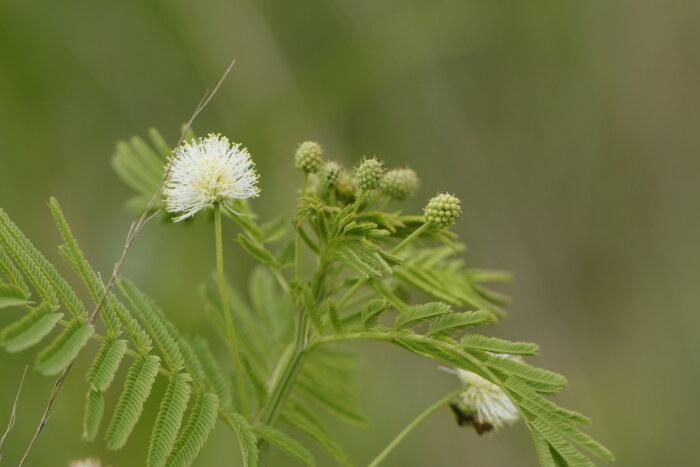Leland Searles works for Meskwaki Natural Resources as an Environmental Specialist Senior. He continues his efforts as a consultant and owner of Leeward Solutions, LLC, a business that offers services in ecological planning and design, field identification and inventory of plants, and natural stream restoration. For more information, see Leeward’s website at http://www.leewardecology.com. All photos of Illinois Bundleflower featured here are Leland’s work and are published with permission.
Illinois Bundleflower (Desmanthus illinoensis) is a somewhat misnamed plant that includes parts of Iowa in its range. While it is found in Illinois, the center of its distribution might be in southern Kansas or Oklahoma. It grows from Mexico north to the Dakotas and east to Illinois and Mississippi. Further east, it occurs as a “species waif,” a plant that requires human management to survive or else disappears in a few generations because it is poorly adapted. Perhaps “Central Plains Bundleflower” would be more apt.
In Iowa, Desmanthus illinoensis has been recorded in four southeastern counties, using the maps at the Biota of North America Project (BONAP), five central Iowa counties, and a brace of counties in the southwest, northwest, and west. It seems to be unevenly distributed, although the gaps may mean only that no herbarium specimens have been collected in those counties.
Illinois Bundleflower also goes by the names Prairie Mimosa and Prickleweed. It prefers sunny, moist areas in wet prairies and wetland margins. Often the species appears in seed mixes for those settings, and so it grows outside the mapped range in reconstructed native plantings. One or a few stems arise from each root.

Once the plant becomes familiar, it is recognized even at a distance by its height of three to four feet and its feathery appearance. That look comes from its twice-compound or bipinnate leaves – each leaf branches along its major veins which bear tiny leaflets. Look closely at the picture below to see the leaflets. Also notice that the leaflets are partly folded, something that occurs in the evening.

Bundleflower belongs in the legume or pea family, Fabaceae, but its flowers outwardly do not look like many other members of the family – the invasive black locust, garden beans and peas, prairie wild indigo, redbud, tick-trefoils, and others. Instead, numerous single flowers are arranged in a round cluster, somewhat more like the flower head of clovers. The flowers are white.

The name, Bundleflower, undoubtedly comes from the seed clusters that form at the top of the plant. Each cluster contains an odd-looking cluster of small, flat pads, each bearing a few seeds. When the pods are fully ripe, they split open, as shown below, to allow the seeds to fall. The empty pods persist well into winter. The seeds are known to rival soybeans in protein content, and the plant has been researched as a perennial alternative for human food. However, the green parts of the plant are known to contain toxic alkaloids and chemicals that produce hallucinations.

As is the case for many plants in the pea family, Illinois Bundleflower roots associate with rhizobium bacteria in the soil to fix nitrogen that the plant needs.
Kentucky Coffeetree (Gymnocladus dioica) shares a subfamily with Bundleflower in the pea family, and it also has bipinnate leaves, although they are much larger. Coffeetree has broad, tough pods with several seeds, and, as the name suggests, those seeds have been used to make a coffee-like, uncaffeinated drink. Another plant with similar features in this subgroup is Partridge-Pea (Chamaecrista fasciculata).


1 Comment
Thank you, Leland Searles
This essay and these photos are really nice. I have really enjoyed seeing Illinois Bundleflower in original prairies, especially in Kansas, Oklahoma, Missouri, and Nebraska. It’s a beautiful and interesting plant.
I was not so happy to see Illinois Bundleflower growing in an Iowa prairie planting that was next to a high-quality original prairie remnant. Good luck to future botanists.
PrairieFan Wed 13 Sep 12:29 AM